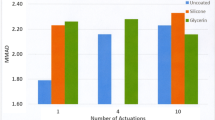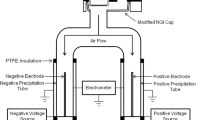Abstract
Purpose
Properly charged particles can be used for effective lung targeting of pharmaceutical aerosols. The objective of this study was to characterize the performance of a new induction charger that operates with a mesh nebulizer for the production of highly charged submicrometer aerosols to bypass the mouth-throat and deliver clinically relevant doses of medications to the lungs.
Methods
Variables of interest included combinations of model drug (albuterol sulfate) and charging excipient (NaCl) as well as strength of the charging field (1–5 kV/cm). Aerosol charge and size were measured using a modified electrical low pressure impactor system combined with high performance liquid chromatography.
Results
At the approximate mass median aerodynamic diameter (MMAD) of the aerosol (~0.4 μm), the induction charge on the particles was an order of magnitude above the field and diffusion charge limit. The nebulization rate was 439.3 ± 42.9 μl/min, which with a 0.1% w/v solution delivered 419.5 ± 34.2 μg of medication per minute. A new correlation was developed to predict particle charge produced by the induction charger.
Conclusions
The combination of the aerosol induction charger and predictive correlations will allow for the practical generation and control of charged submicrometer aerosols for targeting deposition within the lungs.







Similar content being viewed by others
Abbreviations
- AS:
-
Albuterol sulfate
- c i :
-
Thermal speed of the ions (240 m/s at 293°K)
- D :
-
Droplet diameter
- d a :
-
Aerodynamic diameter
- D p :
-
The diameter of residual solid particle in Reischl’s correlation (Eq. 6)
- E :
-
Electric field
- e :
-
Charge of an electron or elementary charge unit (e = 1.6 × 10−19 C)
- ELPI:
-
Electrical Low Pressure Impactor
- GSD:
-
Geometric standard deviation
- H :
-
Induction electrode to orifice plate gap distance
- HPLC:
-
High performance liquid chromatography
- i :
-
The number of recorded ELPI data points (1–60 given the default 1 s sampling time used by the ELPI and 60 s nebulization)
- I i :
-
The current measured at time i for each stage
- I i+1 :
-
The current measured at time i + 1 for each stage
- I stage :
-
Total current recorded for each stage
- K :
-
Relative concentration of solution in Reischl’s correlation (ratio of volume of solute to total volume)
- L :
-
Droplet to orifice distance at the instant of droplet separation
- m AS :
-
Measured mass of AS on each impactor stage
- m f AS :
-
Nominal mass fraction of albuterol sulfate
- m f NaCI :
-
Mass fraction of sodium chloride
- MMAD:
-
Mass median aerodynamic diameter
- m solute :
-
Total mass of deposited solute (i.e. drug and excipient)
- N i :
-
The concentration of ions
- Q :
-
Number of elementary charges on the droplet
- Q/m :
-
Specific charge (charge to mass ratio of the ELPI’s stage)
- Q 0 :
-
Number of elementary charges on the droplet by spraying process
- Q p :
-
Number of elementary charges per particle
- q stage :
-
Total charge on each impactor stage
- t i :
-
The time of data point number i
- t i+1 :
-
The time of data point number i + 1
- V :
-
Charging voltage
- Z i :
-
Mobility of ions
- ρ AS :
-
Density of albuterol sulfate (1.350 g/cm3)
- ρ NaCI :
-
Density of sodium chloride (2.165 g/cm3)
- ρ particle :
-
Density of the multicomponent particle
- α :
-
Correction factor to account for the nonuniformity of the electric field
- β:
-
Induction charging coefficient in Reischl’s correlation (elementary charges per charging voltage Eq. 5)
- ε :
-
Relative permittivity (dielectric constant)
- σ :
-
Conductivity of solution (μS/cm)
References
Melandri C, Prodi V, Tarroni G, Formignani M, De Zaiacomo T, Bompane GF, et al. On the deposition of unipolarly charged particles in the human respiratory tract. Inhaled Part. 1975;4(Pt 1):193–201.
Prodi V, Mularoni A. Electrostatic lung deposition experiments with humans and animals. Ann Occup Hyg. 1985;29(2):229–40.
Vincent JH, Johnston WB, Jones AD, Johnston AM. Static electrification of airborne asbestos: a study of its causes, assessment and effects on deposition in the lungs of rats. Am Ind Hyg Assoc J. 1981;42(10):711–21.
Byron PR, Peart J, Staniforth JN. Aerosol electrostatics. I: properties of fine powders before and after aerosolization by dry powder inhalers. Pharm Res. 1997;14(6):698–705.
Bailey AG, Hashish AH, Williams TJ. Drug delivery by inhalation of charged particles. J Electrost. 1998;44(1–2):3–10.
Vinchurkar S, Longest PW, Peart J. CFD simulations of the Andersen cascade impactor: model development and effects of aerosol charge. J Aerosol Sci. 2009;40(9):807–22.
Ijsebaert JC, Geerse KB, Marijnissen JC, Lammers JW, Zanen P. Electro-hydrodynamic atomization of drug solutions for inhalation purposes. J Appl Physiol (Bethesda, Md : 1985). 2001;91(6):2735–41.
Fu H, Patel AC, Holtzman MJ, Chen D-R. A new electrospray aerosol generator with high particle transmission efficiency. Aerosol Sci Technol. 2011;45(10):1176–83.
Bailey AG. The inhalation and deposition of charged particles within the human lung. J Electrost. 1997;42(1–2):25–32.
Wilson IB. The deposition of charged particles in tubes, with reference to the retention of therapeutic aerosols in the human lung. J Colloid Sci. 1947;2(2):271–6.
Yu CP. Theories of electrostatic lung deposition of inhaled aerosols. Ann Occup Hyg. 1985;29(2):219–27.
Ferin J, Mercer TT, Leach LJ. The effect of aerosol charge on the deposition and clearance of TiO2 particles in rats. Environ Res. 1983;31(1):148–51.
Melandri C, Tarroni G, Prodi V, De Zaiacomo T, Formignani M, Lombardi CC. Deposition of charged particles in the human airways. J Aerosol Sci. 1983;14(5):657–69.
Ali M, Reddy RN, Mazumder MK. Electrostatic charge effect on respirable aerosol particle deposition in a cadaver based throat cast replica. J Electrost. 2008;66(7–8):401–6.
Majid H, Madl P, Hofmann W, Alam K. Implementation of charged particles deposition in stochastic lung model and calculation of enhanced deposition. Aerosol Sci Technol. 2011;46(5):547–54.
Scheuch G, Gebhart J, Roth C. Uptake of electrical charges in the human respiratory tract during exposure to air loaded with negative ions. J Aerosol Sci. 1990;21(Supplement 1(0):S439–42.
Yu CP, Chandra K. Precipitation of submicron charged particles in human lung airways. Bul Math Biol. 1977;39(4):471–8.
Chan TL, Yu CP. Charge effects on particle deposition in the human tracheobronchial tree. Ann Occup Hyg. 1982;26(1–4):65–75.
Azhdarzadeh M, Olfert JS, Vehring R, Finlay WH. Effect of electrostatic charge on oral-extrathoracic deposition for uniformly charged monodisperse aerosols. J Aerosol Sci. 2014;68:38–45.
Azhdarzadeh M, Olfert JS, Vehring R, Finlay WH. Effect of induced charge on deposition of uniformly charged particles in a pediatric oral-extrathoracic airway. Aerosol Sci Technol. 2014;48(5):508–14.
Xi JX, Si XHA, Gaide R. Electrophoretic particle guidance significantly enhances olfactory drug delivery: a feasibility study. Plos One. 2014;9(1):e86593.
Xi J, Si X, Longest W. Electrostatic charge effects on pharmaceutical aerosol deposition in human nasal-laryngeal airways. Pharmaceutics. 2014;6(1):26–35.
Azhdarzadeh M, Olfert JS, Vehring R, Finlay WH. Effect of Electrostatic Charge on Deposition of Uniformly Charged Monodisperse Particles in the Nasal Extrathoracic Airways of an Infant. J Aerosol Med Pul Drug Deliv 2014.
Wong J, Chan HK, Kwok PC. Electrostatics in pharmaceutical aerosols for inhalation. Ther Deliv. 2013;4(8):981–1002.
Cohen B, Xiong J, Li W. The Influence of Charge on the Deposition Behavior of Aerosol Particles with Emphasis on Singly Charged Nanometer Sized Particles. In: Marijnissen JCM, Gradoń L, editors. Aerosol inhalation: recent research frontiers. Netherlands: Springer; 1996. p. 153–64.
Ali M, Mazumder MK, Martonen TB. Measurements of electrodynamic effects on the deposition of MDI and DPI aerosols in a replica cast of human oral-pharyngeal-laryngeal airways. J Aerosol Med Pul Drug Deliv. 2009;22(1):35–44.
Li A, Ahmadi G. Aerosol particle deposition with electrostatic attraction in a turbulent channel flow. J Colloid Interface Sci. 1993;158(2):476–82.
Chang K-N, Chen Y-K, Huang S-H, Chen C-W, Lai C-Y, Chen C-C. Penetration of charged particles through metallic tubes. J Aerosol Sci. 2012;48:10–7.
McMurry PH, Rader DJ. Aerosol wall losses in electrically charged chambers. Aerosol Sci Technol. 1985;4(3):249–68.
Cohen BS, Xiong JQ, Asgharian B, Ayres L. Deposition of inhaled charged ultrafine particles in a simple tracheal model. J Aerosol Sci. 1995;26(7):1149–60.
Finlay WH. 3 - Motion of a single aerosol particle in a fluid. In: Finlay WH, editor. The mechanics of inhaled pharmaceutical aerosols. London: Academic; 2001. p. 17–45.
Hinds WC. Aerosol technology properties, behavior, and measurement of airborne particles. New York: Wiley; 1999.
Chen J, Davidson J. Ozone production in the positive DC corona discharge: model and comparison to experiments. Plasma Chem Plasma Process. 2002;22(4):495–522.
Reischl G, John W, Devor W. Uniform electrical charging of monodisperse aerosols. J Aerosol Sci. 1977;8(1):55–65.
Longest PW, Golshahi L, Hindle M. Improving pharmaceutical aerosol delivery during noninvasive ventilation: effects of streamlined components. Ann Biomed Eng. 2013;41(6):1217–32.
Longest PW, Azimi M, Golshahi L, Hindle M. Improving aerosol drug delivery during invasive mechanical ventilation with redesigned components. Respir Care. 2014;59(5):686–98.
Delvadia R, Hindle M, Longest PW, Byron PR. In vitro tests for aerosol deposition II: IVIVCs for different dry powder inhalers in normal adults. J Aerosol Med Pul Drug Deliv. 2013;26(3):138–44.
Worth Longest P, Hindle M. Numerical model to characterize the size increase of combination drug and hygroscopic excipient nanoparticle aerosols. Aerosol Sci Technol. 2011;45(7):884–99.
Golshahi L, Tian G, Azimi M, Son YJ, Walenga R, Longest PW, et al. The use of condensational growth methods for efficient drug delivery to the lungs during noninvasive ventilation high flow therapy. Pharm Res. 2013;30(11):2917–30.
Najlah M, Vali A, Taylor M, Arafat BT, Ahmed W, Phoenix DA, et al. A study of the effects of sodium halides on the performance of air-jet and vibrating-mesh nebulizers. Int J Pharm. 2013;456(2):520–7.
Longest PW, Walenga RL, Son YJ, Hindle M. High-efficiency generation and delivery of aerosols through nasal cannula during noninvasive ventilation. J Aerosol Med Pul Drug Deliv. 2013;26(5):266–79.
Longest PW, Spence BM, Holbrook LT, Mossi KM, Son YJ, Hindle M. Production of inhalable submicrometer aerosols from conventional mesh nebulizers for improved respiratory drug delivery. J Aerosol Sci. 2012;51:66–80.
ACKNOWLEDGMENTS AND DISCLOSURES
Research reported in this publication was supported by the Eunice Kennedy Shriver National Institute of Child Health & Human Development of the National Institutes of Health under Award Number R21HD073728. The content is solely the responsibility of the authors and does not necessarily represent the official views of the National Institutes of Health.
Author information
Authors and Affiliations
Corresponding author
Rights and permissions
About this article
Cite this article
Golshahi, L., Longest, P.W., Holbrook, L. et al. Production of Highly Charged Pharmaceutical Aerosols Using a New Aerosol Induction Charger. Pharm Res 32, 3007–3017 (2015). https://doi.org/10.1007/s11095-015-1682-6
Received:
Accepted:
Published:
Issue Date:
DOI: https://doi.org/10.1007/s11095-015-1682-6




